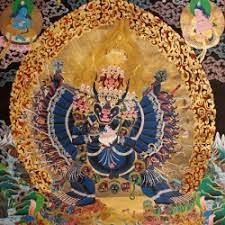Vajra Bhairava: The Wrathful Protector on the Buddhist Path
The Defender and Protector of Those on the Path "I am the Vajra Bhairava, the leader of the Bhairava armies I am a warrior, and I struggle against the forces of illusion and ignorance I also command dakinis and herukas when necessary I emanate clouds of bhairavas for the wars of the Buddhas. While the ultimate goals of Buddhism are peace, freedom, and awareness In the intermediate realms, we do not have emptiness Beings suffer tragedy, or they attack others Out of hatred, and greed, and lust, and delusion. Though such beings are deluded, they may still cause great harm This is why we have defenders of the Vajra worlds And protectors of those on the path. There are many categories of threatening beings There are angry ghosts, and spirits of the dark emotions There are demons who personify pain and horror And repeat tragedies in the victim's mind endlessly, until the person goes insane There are spirits of temptation, who at first appear beautiful But beneath the surface, they squirm, and grasp, and strangle The high Creation Buddhas are themselves dangerous to the weak and uncertain For their emanations are so powerful that a person may be overwhelmed And be unable to stand against them. There are many dangers on the spiritual path Some come by accident, but most result from dark karma Which is often unknown to the seeker This is why it is important to have a protector And also why the protector is a wrathful deity And one who is able to chase away the powers of ignorance and desire. This is why lineages are important They can assign protectors But if a person is worthy, he or she will be protected regardless A spiritual person shines with an inner light Which is invisible to the physical world, but is visible in the other worlds. I may be visualized as a shining moon behind thunder clouds As a sun whose rays are shooting vajra knives and spears As a white lion in the mountains, leaping and flying among the rocky peaks As a guardian statue at the entrance of a temple. Deities do not exist, yet I defend and command them Souls do not exist, yet I protect them Buddhas do not exist, yet I serve them The Void does not exist, yet all of the worlds depend upon it. I am an armed black warrior on a winged horse, slaying ignorance I am a naked ascetic in a cave, slaying lust I am a bodhisattva of light, slaying hatred and illusion. Sincere seekers may call upon me for help But those who seek to manipulate and gain power Will be destroyed along with their desires."
Introduction: Vajra Bhairava stands as a formidable figure in the realm of Buddhist deities, embodying the essence of a fierce and protective force against the adversities that can impede the spiritual journey. This wrathful manifestation serves as a guardian, defending practitioners from the pitfalls of illusion and ignorance that may obstruct the path to peace, freedom, and awareness.
The Warrior against Forces of Illusion: As the leader of the Bhairava armies, Vajra Bhairava assumes the role of a warrior engaged in a relentless struggle against the forces of illusion and ignorance. In Buddhist philosophy, the ultimate goals are centered around peace and enlightenment, yet the intermediate realms are fraught with challenges where beings, driven by hatred, greed, lust, and delusion, may cause harm.
Commander of Dakinis and Herukas: Vajra Bhairava's influence extends beyond personal defense; the deity also commands dakinis and herukas when necessary. This signifies a broader role in orchestrating spiritual energies and forces, emphasizing the collective effort in combating obstacles on the path to enlightenment.
Emanator of Bhairavas for the Wars of the Buddhas: The deity emanates clouds of bhairavas, symbolic of the collective spiritual warriors engaged in the wars of the Buddhas. This imagery underscores the idea that the pursuit of enlightenment is not a solitary endeavor but a collective struggle against the various challenges presented in the intermediate realms.
Categories of Threatening Beings: Vajra Bhairava's protective role extends to guarding against different categories of threatening beings. Angry ghosts, spirits of dark emotions, demons embodying pain and horror, and seductive spirits of temptation pose challenges to spiritual seekers. The deity's wrathful nature becomes essential in dispelling these influences, ensuring the aspirant's safety on the spiritual journey.
The Importance of Protectors on the Spiritual Path: Dangers on the spiritual path may arise inadvertently or result from dark karma, often unknown to the seeker. Protectors, such as Vajra Bhairava, play a crucial role in safeguarding practitioners. Lineages can assign protectors, but the worthiness of an individual can also attract protection. A spiritually illuminated person emits an inner light visible in realms beyond the physical, signifying a connection with the protective forces.
Visualization and Symbolism: Vajra Bhairava can be visualized in various forms, such as a shining moon behind thunder clouds, a sun emitting vajra knives and spears, a white lion leaping among rocky peaks, or a guardian statue at a temple entrance. These visualizations carry symbolic significance, representing the deity's multifaceted nature and the diverse challenges practitioners may encounter.
Paradoxical Existence and Deity's Purpose: The paradoxical nature of Vajra Bhairava's existence, where deities, souls, Buddhas, and the Void are stated not to exist, underscores the transcendental understanding of reality in Buddhism. The deity's purpose lies in defending and serving entities that conventionally don't exist, illustrating the interconnectedness of all phenomena.
Invocation and Caution: Sincere seekers are encouraged to call upon Vajra Bhairava for assistance on their spiritual journey. However, a cautionary note is sounded for those seeking to manipulate or gain power, as their desires may be destroyed along with them. This emphasizes the importance of sincerity and purity of intention in seeking divine assistance.
Conclusion: In the intricate tapestry of Buddhist cosmology, Vajra Bhairava emerges as a dynamic and protective force, embodying the wrathful aspect necessary to overcome the challenges faced by sincere seekers on their spiritual path. The deity's symbolism, visualizations, and role in defending against threatening forces collectively contribute to the rich tapestry of Buddhist mythology and practice.



